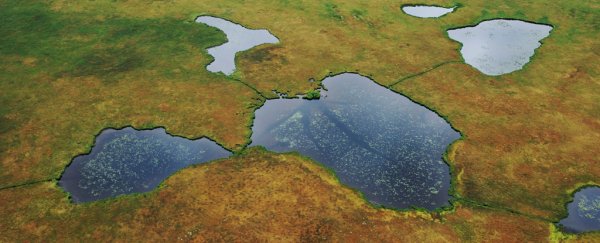Most of us know about the vast stores of carbon in our atmosphere, and yet beneath our feet, Earth's soil contains nearly three times as much CO2, absorbing roughly a quarter of all human emissions each year.
If the world warms by 2 °C or more, we risk turning that vital sink into a carbon spout.
An updated model on carbon soil turnover has found such warming could release 230 billion tons of carbon dioxide, give or take 50 billion tons. And that's just from the top metre of soil, which includes roughly the same amount of carbon as our atmosphere.
That number is a little under what China has emitted since 1900 and slightly less than double what the United States has emitted since the same year.
Restricting a model to such shallow depths might sound like an oversight at first, but by confining their measurements, scientists have made it easier to model changes in soil turnover. This has also helped halve the uncertainty produced by other similar models.
"We have reduced the uncertainty in this climate change response, which is vital to calculating an accurate global carbon budget and successfully meeting Paris Agreement targets," says climate scientist Peter Cox from the Global Systems Institute.
While warming temperatures are known to increase decomposition and shorten the amount of time carbon spends in the soil, it's still not clear how sensitive this system is to temperature changes.
In fact, the way soil responds to our rapidly changing world is one of the greatest uncertainties in our current climate models. And while the new research isn't the worst prediction out there, it's still not good news.
"Our study rules out the most extreme projections – but nonetheless suggests substantial soil carbon losses due to climate change at only 2°C warming, and this doesn't even include losses of deeper permafrost carbon," says climate modeller Sarah Chadburn from the University of Exeter.
Nor does it include other greenhouse gases, like methane, which are also stored in the soil and which are many times more powerful as a global warmer than carbon dioxide.
Of course, not all soil holds the same amount of carbon, and while some parts of the world hold the potential to increase their soil sink, other parts are not so lucky.
Most soil carbon is stored in peatland or permafrost, and unfortunately, these common Arctic habitats are on the frontlines of global warming.
Today, with rapid permafrost collapse under way, scientists are worried we will soon hit a tipping point, where vast stores of carbon trigger more melt and increased emissions at a runaway pace.
Recent research, for instance, has found that as permafrost melts, rising temperatures are stimulating plant growth, and these spreading roots are 'priming' permafrost for further thawing.
Such minute interactions are easy to overlook in such a complicated system, but they could blow holes in our current climate goals.
"Climate–carbon cycle feedbacks must be understood and quantified if the Paris Agreement Targets are to be met," researchers of the new model write.
"Changes in soil carbon represent a particularly large uncertainty, with the potential to significantly reduce the carbon budget for climate stabilisation at 2 °C global warming."
The carbon in Earth's soil has been building up for millennia. If we lose it, we might not get it back again.
What we do about it now will determine our future.
The study was published in Nature Communications.
